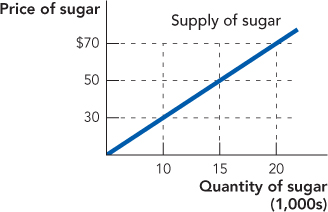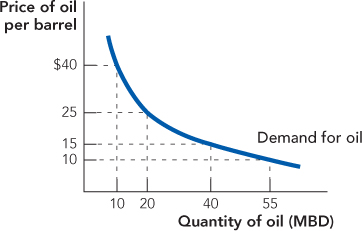3.1 CHAPTER REVIEW
FACTS AND TOOLS
Question 3.5
1. When the price of a good increases, the quantity demanded ______. When the price of a good decreases, the quantity demanded _____.
Question 3.6
2. When will people search harder for substitutes for oil: When the price of oil is high or when the price of oil is low?
Question 3.7
3. Your roommate just bought a Nike+ Sportwatch for $160. She would have been willing to pay $250 for a device that could improve her morning runs by measuring the speed, distance, and duration of the runs, and calculating the calories she burns. How much consumer surplus does your roommate enjoy from the Nike+ Sportwatch?
Question 3.8
4. What are three things that you’ll buy less of once you graduate from college and get a good job? What kinds of goods are these called?
Question 3.9
5. When the price of Apple MacBooks goes down, what probably happens to the demand for laptops featuring Microsoft Windows?
Question 3.10
6.
When the price of olive oil goes up, what probably happens to the demand for corn oil?
42
When the price of petroleum goes up, what probably happens to the demand for natural gas? To the demand for coal? To the demand for solar power?
Question 3.11
7.
If everyone thinks that the price of tomatoes will go up next week, what is likely to happen to demand for tomatoes today?
If everyone thinks that the price of gasoline will go up next week, what is likely to happen to the demand for gasoline today? (Note: Is this change in demand caused by consumers or by gas station owners?)
Question 3.12
8. Along a supply curve, if the price of oil falls, what will happen to the quantity of oil supplied? Why?
Question 3.13
9. If the price of cars falls, are carmakers likely to make more or fewer cars, according to the supply curve? (Notice that the “person on the street” often thinks the opposite is true!)
Question 3.14
10. When is a pharmaceutical business more likely to hire highly educated, cutting-edge workers and use new, experimental research methods: When the business expects the price of its new drug to be low or when it expects the price to be high?
Question 3.15
11. Imagine that a technological innovation reduces the costs of producing high-quality steel. What happens to the supply curve for steel?
Question 3.16
12. When oil companies expect the price of oil to be higher next year, what happens to the supply of oil today?
Question 3.17
13. Do taxes usually increase the supply of a good or reduce the supply?
THINKING AND PROBLEM SOLVING
Question 3.18
1. Consider the following supply curve for oil. Note that MBD stands for “millions of barrels per day,” the usual way people talk about the supply of oil:

Based on this supply curve, fill in the table:
Price
Quantity Supplied
$12
40
If the price for a barrel of oil was $15, how much oil would oil suppliers be willing to supply?
What is the lowest price at which suppliers of oil would be willing to supply 20 MBD?
Question 3.19
2. From the following table of prices per 100 pencils and quantities supplied (in hundreds of pencils), draw the supply curve for pencils:
|
Price |
Quantity Supplied |
|---|---|
|
$5 |
20 |
|
$15 |
40 |
|
$25 |
50 |
|
$35 |
55 |
Question 3.20
3. Suppose LightBright and Bulbs4You were the only two suppliers of lightbulbs in Springfield. Draw the supply curve for the lightbulb industry in Springfield from the following tables for the two companies. To create this “lightbulb industry supply curve,” note that you’ll add up the total number of bulbs that the industry will supply at a price of $1 (15 bulbs), and then do the same for the prices of $5, $7, and $10.
|
Price |
Bulbs Supplied by Lightbright |
Bulbs Supplied by Bulbs4You |
|---|---|---|
|
$1 |
10 |
5 |
|
$5 |
15 |
7 |
|
$7 |
25 |
15 |
|
$10 |
35 |
20 |
43
Question 3.21
4. Using the following diagram, identify and calculate total producer surplus if the price of oil is $50 per barrel. Recall that for a triangle, Area = (1/2) × Base × Height. (You never thought you’d use that equation unless you became an engineer, did you?)

Question 3.22
5. In Sucrosia, the supply curve for sugar is as follows:
|
Price (per 100-pound bag) |
Quantity |
|---|---|
|
$30 |
10,000 |
|
$50 |
15,000 |
|
$70 |
20,000 |

Under pressure from nutrition activists, the government decides to tax sugar producers with a $5 tax per 100-pound bag. Using the figure above, draw the new supply curve. After the tax is enacted, what price will bring forth quantities of 10,000? 15,000? 20,000? Give your answers in the table:
|
Price (per 100-pound bag) |
Quantity |
|---|---|
|
|
10,000 |
|
|
15,000 |
|
|
20,000 |
Question 3.23
6. Consider the farmers talked about in the chapter who have land that is suitable for growing both wheat and soybeans. Suppose all farmers are currently farming wheat but the price of soybeans rises dramatically.
Does the opportunity cost of producing wheat rise or fall?
Does this shift the supply curve for wheat (as in one of the panels of Figure 3.11), or is it a movement along a fixed supply curve? What direction is this shift or movement? Illustrate your answer in the following figure:

Question 3.24
7. Consider the following demand curve for oil:

Using this demand curve, fill in the following table:
Price
Quantity Demanded
55
$25
44
If the price was $10, how much oil would be demanded?
What is the maximum price (per barrel) that demanders will pay for 20 million barrels of oil?
Question 3.25
8. From the following chart, draw the demand curve for pencils (in hundreds):
|
Price |
Quantity Demanded (100s) |
|---|---|
|
$5 |
60 |
|
$15 |
45 |
|
$25 |
35 |
|
$35 |
20 |
Question 3.26
9. If the price of glass dramatically increases, what are we likely to see a lot less of: glass windows or glass bottles? Why?
Question 3.27
10. Let’s think about the demand for LED TVs.
If the price for a 60-inch LED TV is $800, and Newhart would be willing to pay $3,000, what is Newhart’s consumer surplus?
Consider the following figure for the total demand for LED TVs. At $800 per TV, 1,200 TVs were demanded. What would be the total consumer surplus? Calculate the total, and identify it on the diagram.

Where is Newhart in the figure?
Question 3.28
11. If income increases and the demand for good X shifts as shown in the figure, then is good X a normal or inferior good? Give an example of a good like good X.

Question 3.29
12. Assume that butter and margarine are substitutes. What will happen to the demand curve for butter if the price of margarine increases? Why?
Question 3.30
13. Cars and gasoline are complements. What will happen to the demand curve for gasoline if the price of cars decreases? Why? (Hint: What happens to the quantity demanded of cars?)
Question 3.31
14. Suppose that the supply curve for solar panels is as shown in the diagram:

The government decides that it would like to increase the quantity of solar panels in use, so it offers a $20 subsidy per panel to producers. Draw the new supply curve. (Hint: Remember our analysis of how a tax affects supply, as shown in Figure 3.12, and bear in mind that a subsidy can be thought of as a “negative tax.”)
45
CHALLENGES
Question 3.32
1. Michael is an economist. He loves being an economist so much that he would do it for a living even if he only earned $30,000 per year. Instead, he earns $80,000 per year. (Note: This is the average salary of new economists with a PhD degree.) How much producer surplus does Michael enjoy?
Question 3.33
2. The economist Bryan Caplan recently found a pair of $10 arch supports that saved him from the pain of major foot surgery. As he stated on his blog (econlog.econlib.org), he would have been willing to pay $100,000 to fix his foot problem, but instead he paid only a few dollars.
How much consumer surplus did Bryan enjoy from this purchase?
If the sales tax was 5 percent on this product, how much revenue did the government raise when Bryan bought his arch supports?
If the government could have taxed Bryan based on his willingness to pay rather than on how much he actually paid, how much sales tax would Bryan have had to pay?
Question 3.34
3. For most young people, working full-time and going to school are substitutes: You tend to do one or the other. When it’s tough to find a job, does that raise the opportunity cost of going to college or does it lower it? When it’s tough to find a job, does the demand for college rise or fall?
Question 3.35
4. What should happen to the “demand for speed” (measured by the average speed on highways) once airbags are included on cars?
Question 3.36
5. The industrial areas in northeast Washington, D.C., were relatively dangerous in the 1980s. Over the last two decades, the area has become a safer place to work (although there are still several times more violent crimes per person in these areas compared with another D.C. neighborhood, Georgetown). When an area becomes a safer place to work, what probably happens to the “supply of labor” in that area?
!launch! WORK IT OUT
The supply curve for rice is as follows:
|
Price (per 100-lb. bag) |
Quantity |
|---|---|
|
$40 |
10,000 |
|
$60 |
15,000 |
|
$80 |
20,000 |

Under pressure from nutrition activists, the government decides to tax rice producers with a $5 tax per 100-pound bag. Using the preceding figure, draw the new supply curve. After the tax is enacted, what price will bring forth quantities of 10,000? 15,000? 20,000? Give your answers in the table:
|
Price (per 100-lb. bag) |
Quantity |
|---|---|
|
|
10,000 |
|
|
15,000 |
|
|
20,000 |
46
* It is equally correct to think of new entrants as shifting the supply curve down. Remember, it’s ultimately costs that shift supply, and what increases supply is entry of lower-cost producers. Industry costs fell when Canadian producers entered the market because many Canadian producers had lower costs than some U.S. producers. As lower-cost Canadian producers entered the industry, higher-cost U.S. producers exited the industry, and industry costs decreased, thus shifting the supply curve down.